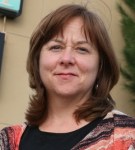I am excited to post my interview with author Karen Kane whose debut novel, Charlie & Frog (Disney-Hyperion), came out April 10. I had the pleasure of previewing this book and getting to hear the backstory.

Hi Karen! Please give us a short summary of the book.
Charlie has been dumped with his TV-obsessed grandparents in the village of Castle-on-the-Hudson. When an old woman disappears after giving Charlie a desperate message in sign language, Charlie is determined to find answers.
Frog, who is Deaf, would rather be solving crimes than working at the Flying Hands Café. When Charlie walks into the café looking for help, Frog jumps at the chance to tackle a real-life case.
Together, Charlie and Frog set out to decipher a series of clues and uncover the truth behind the mysterious message. Charlie needs to learn American Sign Language to keep up with Frog. And Frog needs to gather her detective know-how to break the case before it’s too late.
What two book titles and/or movie titles would you say Charlie & Frog is a cross between?
My hope is that Charlie & Frog has the heart of Roald Dahl’s Danny the Champion of the World and the humor of Matilda.
Why did you choose the setting you did?
I choose to set Charlie & Frog in the Hudson Valley because, for some inexplicable reason, I have a soul connection with that part of New York. Maybe because it’s the home of one of my favorite detectives, Trixie Belden!
Is it based on any real location?
Castle-on-the-Hudson is a part Cold Spring, NY, part Cape May, NJ and part Pittsford, NY, the village where I grew up.
Would you say you’re more like Charlie or Frog? Why?
I am definitely more like Charlie. I have always had a deep-seated longing for connection and community—and like Charlie I had to learn to look inward to find it. Frog is super-confident and knows herself. I am becoming more like Frog, but I will never reach her level of moxie!

I love how Charlie & Frog has a main character who is deaf but that the book isn’t an issues book. And I thoroughly enjoyed how you could show conversations of characters without spoken words. I know you graduated from the National Technical Institute for the Deaf and are a sign language interpreter. How did you become interested in working with people who are deaf?
True confession time: the real reason I became a sign language interpreter is because I failed microbiology in my 2nd year of nursing studies. There was no way I was taking that class again, so I changed my major to one that didn’t require microbiology to graduate—interpreting! I wish I had a more profound reason, but it was an intuitive decision. And the right decision because I have truly loved my work. And interpreting was what connected me to the community who inspired Charlie & Frog.
What research did you end up doing for this book that you didn’t realize you’d need to? What are you currently working on?
All the research I did for the book I ended up using—such as the Dewey decimal system, as well as some Deaf history. And I had Deaf readers give me feedback on how I portrayed Deaf characters and culture in Charlie & Frog.
I am currently writing the next Charlie & Frog book, tentatively called The Boney Hand. The second book happens in the fall, my favorite time of year.
After reading a book, I love knowing what was originally pitched when submitted. Do you remember what your elevator pitch was for Charlie & Frog? After editing, would you say your elevator pitch has changed?
I’m lousy at elevator pitches! Thank goodness I didn’t need one this time because I already had an agent, Jennifer Carlson, who had tried to sell my first book, The Hayley Show. Although Jennifer and I both loved it, we couldn’t find an editor who also did. Ten years later (!) I sent Jennifer Charlie & Frog, which I wrote while attending Vermont College of Fine Arts. This time we were lucky to find several editors who loved it as well. Tracey Keevan, at Disney Hyperion, bought it at auction.
If I did have an elevator pitch, it would still be the same pitch even after the editing process, because the heart and soul and humor of Charlie & Frog have never changed—they have only deepened.
Thank you, Karen, for letting me pick your brain! I highly recommend Charlie & Frog for middle grade readers.
A copy of Charlie & Frog will be given away to one lucky winner! Post a comment below for a chance to win a copy of Karen’s book (shipping within the U.S. only).



 Mary Kay Carson: How did this book come about?
Mary Kay Carson: How did this book come about?
 More about
More about  Your host this week is
Your host this week is 



